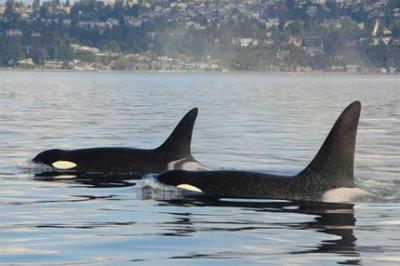
A Gal Named Spock

The first daughter of matriarch Skagit (K13), she was born in 1986. She has three siblings and a nephew: brother Scoter (K25), born 1991; sister Deadhead (K27), born 1994, and her son K44, born 2011; and brother Cali (K34), born 2001. She has a tall dorsal fin for a female, and researchers thought she might be a “he” until – surprise – Mark Sears and I saw Spock (K20) in Colvos Pass with her newborn son Comet (K38) on December 22, 2004.
Spock is one of my favorite gals in our endangered Southern Resident Community. I have numerous fond memories of her, dating back to 1992. One halcyon evening that summer, I watched a superpod in Haro Strait from the west side of San Juan Island. I perched on the rocks south of Lime Kiln Park, at the edge of the water. Young Spock (K20) and Cappuccino (K21), both six years old at the time, socialized and luxuriated in the nearshore kelp with their K Pod relatives.
I was babbling to the orcas – with words and sounds that I would deem silly two decades later -- when wee Spock spyhopped, eyeing the shore. A woman standing next to me exclaimed, “That whale just looked at you!”
I do not presume Spock was looking at me; however, that proved to be the first of many encounters I have had with K20 and her gorgeous family where she was close to shore – on Vashon and on San Juan Island.
Spock is a regular in photos snapped at Point Robinson. I marvel at how many pictures I have of her and her K13 matriline, sent to me over the years. When K Pod visited on January 5, K20 and her close relatives were the whales most-photographed from shore.
Grandma Skagit (K13), now 42, and her offspring often exhibit remarkable behavior. I have photos of them sharing a chum salmon in 2007, as well as several images showing the beautiful bellies and inverted tail slaps of Spock and her kin.
A plausible explanation for why a barbed dart remains lodged in the dorsal fin of Scoter (K25) is that another orca knocked off his satellite tag. A member of his close-knit, extremely tactile family -- perhaps his sister Spock -- likely removed the foreign object.
Odin and I had a productive encounter with the Ks on January 5, observing them along Maury Island and into Dalco Pass. I speculate that they finally traveled through Dalco and Colvos Passes before dark because Transients were not in the area. On an otherwise stellar day with our beloved Kéet, intrusive boaters tarnished the experience slightly.
The orcas were noticeably more relaxed after the boats left. At sunset, they rendered a striking vision in the lavender sea, logging and gently slapping their flippers and flukes. If history is any indicator, we will not see them again for many months. In 2012, K Pod departed Island waters on December 29 and did not return here until December 1, 2013. I said goodbye to Spock and her relatives as they made their customary winter farewell loop around Vashon-Maury.
Please support the work of the Vashon Hydrophone Project (VHP): REPORT LOCAL WHALE SIGHTINGS ASAP TO 463-9041, as well as seal pups and sick, injured, or dead marine mammals on Island beaches. Prompt reports to the VHP expedite vital data collection efforts by Mark Sears and other researchers, and sustain an accurate record of whale sightings for Vashon-Maury initiated three decades ago. Send photos to Orca Annie at Vashonorcas@aol.com.
- Login to post comments
